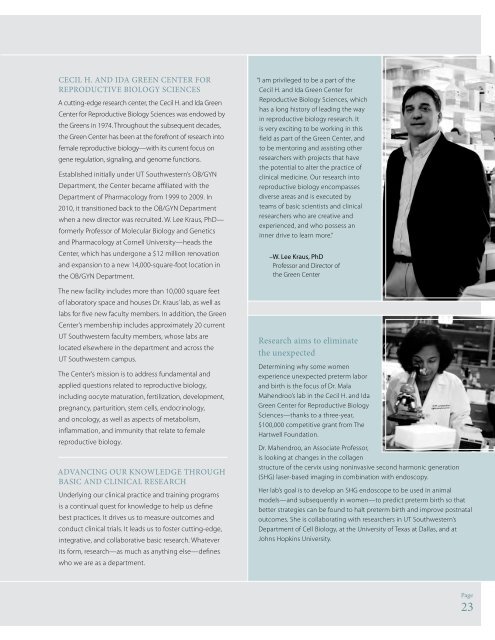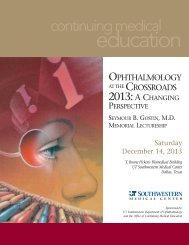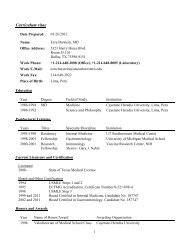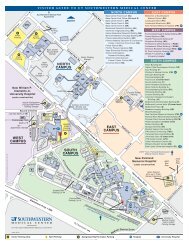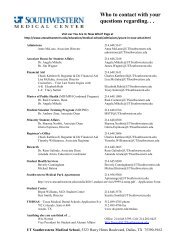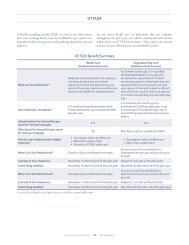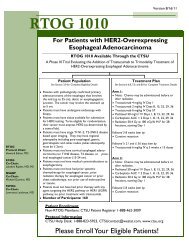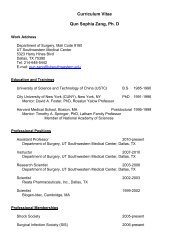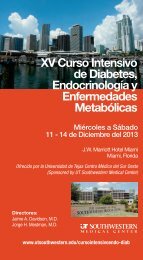Department of Obstetrics and Gynecology - UT Southwestern
Department of Obstetrics and Gynecology - UT Southwestern
Department of Obstetrics and Gynecology - UT Southwestern
Create successful ePaper yourself
Turn your PDF publications into a flip-book with our unique Google optimized e-Paper software.
Cecil H. <strong>and</strong> Ida Green Center for<br />
Reproductive Biology Sciences<br />
A cutting-edge research center, the Cecil H. <strong>and</strong> Ida Green<br />
Center for Reproductive Biology Sciences was endowed by<br />
the Greens in 1974. Throughout the subsequent decades,<br />
the Green Center has been at the forefront <strong>of</strong> research into<br />
female reproductive biology—with its current focus on<br />
gene regulation, signaling, <strong>and</strong> genome functions.<br />
Established initially under <strong>UT</strong> <strong>Southwestern</strong>’s OB/GYN<br />
<strong>Department</strong>, the Center became affiliated with the<br />
<strong>Department</strong> <strong>of</strong> Pharmacology from 1999 to 2009. In<br />
2010, it transitioned back to the OB/GYN <strong>Department</strong><br />
when a new director was recruited. W. Lee Kraus, PhD—<br />
formerly Pr<strong>of</strong>essor <strong>of</strong> Molecular Biology <strong>and</strong> Genetics<br />
<strong>and</strong> Pharmacology at Cornell University—heads the<br />
Center, which has undergone a $12 million renovation<br />
<strong>and</strong> expansion to a new 14,000-square-foot location in<br />
the OB/GYN <strong>Department</strong>.<br />
The new facility includes more than 10,000 square feet<br />
<strong>of</strong> laboratory space <strong>and</strong> houses Dr. Kraus’ lab, as well as<br />
labs for five new faculty members. In addition, the Green<br />
Center’s membership includes approximately 20 current<br />
<strong>UT</strong> <strong>Southwestern</strong> faculty members, whose labs are<br />
located elsewhere in the department <strong>and</strong> across the<br />
<strong>UT</strong> <strong>Southwestern</strong> campus.<br />
The Center’s mission is to address fundamental <strong>and</strong><br />
applied questions related to reproductive biology,<br />
including oocyte maturation, fertilization, development,<br />
pregnancy, parturition, stem cells, endocrinology,<br />
<strong>and</strong> oncology, as well as aspects <strong>of</strong> metabolism,<br />
inflammation, <strong>and</strong> immunity that relate to female<br />
reproductive biology.<br />
Advancing Our Knowledge Through<br />
Basic <strong>and</strong> Clinical Research<br />
Underlying our clinical practice <strong>and</strong> training programs<br />
is a continual quest for knowledge to help us define<br />
best practices. It drives us to measure outcomes <strong>and</strong><br />
conduct clinical trials. It leads us to foster cutting-edge,<br />
integrative, <strong>and</strong> collaborative basic research. Whatever<br />
its form, research—as much as anything else—defines<br />
who we are as a department.<br />
“I am privileged to be a part <strong>of</strong> the<br />
Cecil H. <strong>and</strong> Ida Green Center for<br />
Reproductive Biology Sciences, which<br />
has a long history <strong>of</strong> leading the way<br />
in reproductive biology research. It<br />
is very exciting to be working in this<br />
field as part <strong>of</strong> the Green Center, <strong>and</strong><br />
to be mentoring <strong>and</strong> assisting other<br />
researchers with projects that have<br />
the potential to alter the practice <strong>of</strong><br />
clinical medicine. Our research into<br />
reproductive biology encompasses<br />
diverse areas <strong>and</strong> is executed by<br />
teams <strong>of</strong> basic scientists <strong>and</strong> clinical<br />
researchers who are creative <strong>and</strong><br />
experienced, <strong>and</strong> who possess an<br />
inner drive to learn more.”<br />
–W. Lee Kraus, PhD<br />
Pr<strong>of</strong>essor <strong>and</strong> Director <strong>of</strong><br />
the Green Center<br />
Research aims to eliminate<br />
the unexpected<br />
Determining why some women<br />
experience unexpected preterm labor<br />
<strong>and</strong> birth is the focus <strong>of</strong> Dr. Mala<br />
Mahendroo’s lab in the Cecil H. <strong>and</strong> Ida<br />
Green Center for Reproductive Biology<br />
Sciences—thanks to a three-year,<br />
$100,000 competitive grant from The<br />
Hartwell Foundation.<br />
Dr. Mahendroo, an Associate Pr<strong>of</strong>essor,<br />
is looking at changes in the collagen<br />
structure <strong>of</strong> the cervix using noninvasive second harmonic generation<br />
(SHG) laser-based imaging in combination with endoscopy.<br />
Her lab’s goal is to develop an SHG endoscope to be used in animal<br />
models —<strong>and</strong> subsequently in women—to predict preterm birth so that<br />
better strategies can be found to halt preterm birth <strong>and</strong> improve postnatal<br />
outcomes. She is collaborating with researchers in <strong>UT</strong> <strong>Southwestern</strong>’s<br />
<strong>Department</strong> <strong>of</strong> Cell Biology, at the University <strong>of</strong> Texas at Dallas, <strong>and</strong> at<br />
Johns Hopkins University.<br />
Page<br />
23


